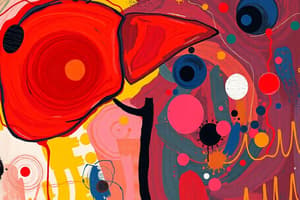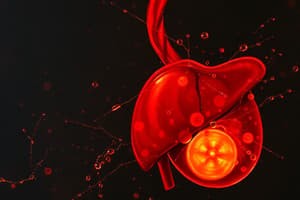Podcast
Questions and Answers
What condition is indicated by a deficiency or suppression of UDP transferase, specifically in neonates?
What condition is indicated by a deficiency or suppression of UDP transferase, specifically in neonates?
- Dubin-Johnson syndrome
- Gilbert's disease
- Obstructive jaundice
- Crigler-Najjar syndrome (correct)
In which condition does post-conjugation failure occur?
In which condition does post-conjugation failure occur?
- Dubin-Johnson syndrome (correct)
- Crigler-Najjar syndrome
- Neonatal jaundice
- Gilbert's disease
What can be inferred if both raised bilirubin and normal liver enzymes are observed?
What can be inferred if both raised bilirubin and normal liver enzymes are observed?
- Biliary obstruction
- Acute liver disease
- Gilbert's disease (correct)
- Cholecystitis
What is the primary source of bilirubin in the body?
What is the primary source of bilirubin in the body?
What does a raise in conjugated bilirubin fraction in the plasma typically indicate?
What does a raise in conjugated bilirubin fraction in the plasma typically indicate?
Which bilirubin level range is considered normal for unconjugated bilirubin in adults?
Which bilirubin level range is considered normal for unconjugated bilirubin in adults?
What condition is characterized by bilirubin transport disturbances due to pre-conjugation failure?
What condition is characterized by bilirubin transport disturbances due to pre-conjugation failure?
Which of the following is NOT a common cause of obstructive jaundice?
Which of the following is NOT a common cause of obstructive jaundice?
What type of bilirubin is primarily excreted via the bile duct?
What type of bilirubin is primarily excreted via the bile duct?
Which enzyme is primarily responsible for converting bilirubin into its conjugated form?
Which enzyme is primarily responsible for converting bilirubin into its conjugated form?
What is the main source of bilirubin production in the body?
What is the main source of bilirubin production in the body?
Which condition would most likely lead to an increase in unconjugated bilirubin in plasma?
Which condition would most likely lead to an increase in unconjugated bilirubin in plasma?
What is the clinical significance of a plasma bilirubin level greater than 50 µmol/L?
What is the clinical significance of a plasma bilirubin level greater than 50 µmol/L?
What proportion of bilirubin in a normal serum is in the conjugated form?
What proportion of bilirubin in a normal serum is in the conjugated form?
Which of the following best describes hyperbilirubinaemia?
Which of the following best describes hyperbilirubinaemia?
What type of jaundice is primarily caused by increased breakdown of red blood cells?
What type of jaundice is primarily caused by increased breakdown of red blood cells?
Which of the following tests would be most relevant in assessing haemolytic jaundice?
Which of the following tests would be most relevant in assessing haemolytic jaundice?
Bilirubin primarily exists in which forms in serum?
Bilirubin primarily exists in which forms in serum?
What is a major consequence of interrupted bilirubin removal in the body?
What is a major consequence of interrupted bilirubin removal in the body?
Which statement about bile is correct?
Which statement about bile is correct?
Flashcards
What is bilirubin?
What is bilirubin?
Bilirubin is a yellow pigment produced from the breakdown of heme, a component of hemoglobin found in red blood cells.
What does the liver produce?
What does the liver produce?
The liver is responsible for producing bile, which contains bile acids and bilirubin. Bile acids are cholesterol derivatives, while bilirubin results from hemoglobin breakdown.
What is the primary pigment in Bile?
What is the primary pigment in Bile?
Bilirubin is the main pigment in bile. It's formed when aged red blood cells are broken down by the reticuloendothelial system.
Where does most bilirubin come from?
Where does most bilirubin come from?
Signup and view all the flashcards
How is bilirubin processed in the liver?
How is bilirubin processed in the liver?
Signup and view all the flashcards
Where does conjugated bilirubin end up?
Where does conjugated bilirubin end up?
Signup and view all the flashcards
What are the normal bilirubin levels in the blood?
What are the normal bilirubin levels in the blood?
Signup and view all the flashcards
What is jaundice?
What is jaundice?
Signup and view all the flashcards
Why does jaundice happen?
Why does jaundice happen?
Signup and view all the flashcards
How is jaundice classified?
How is jaundice classified?
Signup and view all the flashcards
Conjugation Failure Jaundice
Conjugation Failure Jaundice
Signup and view all the flashcards
Neonatal Jaundice
Neonatal Jaundice
Signup and view all the flashcards
Crigler-Najjar Syndrome
Crigler-Najjar Syndrome
Signup and view all the flashcards
Bilirubin Transport Disturbances
Bilirubin Transport Disturbances
Signup and view all the flashcards
Gilbert's Disease
Gilbert's Disease
Signup and view all the flashcards
Dubin-Johnson Syndrome
Dubin-Johnson Syndrome
Signup and view all the flashcards
Obstructive Jaundice
Obstructive Jaundice
Signup and view all the flashcards
Liver Enzymes
Liver Enzymes
Signup and view all the flashcards
Bilirubin in Urine
Bilirubin in Urine
Signup and view all the flashcards
Bilirubin
Bilirubin
Signup and view all the flashcards
Study Notes
Liver Function Tests - Plasma Bilirubin
- Bilirubin is a breakdown product of haemoglobin, a component of red blood cells.
- The liver produces bile, which contains bile acids (cholesterol metabolites) and bilirubin.
- Bilirubin is the main pigment in bile.
- Approximately 85% of daily bilirubin comes from haemoglobin breakdown, while the remaining comes from red blood cell precursors and other haem-containing proteins (myoglobin, cytochromes, catalase).
- Aged red blood cells are phagocytised by the reticuloendothelial system to release bilirubin.
Bilirubin Metabolism
- Bilirubin is transported in the blood bound to albumin.
- The liver takes bilirubin into the cells via cell membrane-receptor carriers.
- Inside the liver cells, bilirubin is conjugated with glucuronic acid via the action of uridine diphosphate glucuronyl transferase.
- Conjugated bilirubin is water-soluble and excreted into bile via the bile duct.
- In the small intestine, bilirubin is converted to urobilinogen by intestinal bacteria.
- Most urobilinogen is converted to stercobilin and excreted in the faeces.
- A small amount of urobilinogen is reabsorbed into the bloodstream, transported to the liver, and then excreted into the urine.
Bilirubin Levels and Jaundice
- Normal serum bilirubin levels are in the range of 0.2-1.0 mg/dL (3-17 μmol/L).
- A small proportion, approximately 20% (0.2 mg/dL), is in the conjugated form.
- Clinically significant jaundice occurs when plasma bilirubin levels exceed 50 μmol/L.
- Jaundice is characterized by the yellowish pigmentation of the sclera (whites of the eyes) and skin, due to increased bilirubin concentrations in the blood.
- Jaundice occurs when the rate of bilirubin production exceeds the liver's capacity to process and excrete it.
Causes of Increased Bilirubin in Blood
- Haemolysis/Ineffective erythropoiesis: Increased haemoglobin breakdown products, resulting in high bilirubin levels.
- Hepatic causes: Problems with the liver's ability to conjugate bilirubin, such as defective conjugation systems or insufficient uptake.
- Obstruction of the biliary system: Obstructions prevent conjugated bilirubin from entering the small intestine, causing bilirubin to accumulate in the blood.
Types of Jaundice and Diagnostic Tests
- Pre-hepatic jaundice (haemolytic)
- Hepatic jaundice (hepatocellular damage)
- Post-hepatic jaundice (obstructive)
- Tests for jaundice include urinary urobilinogen and bilirubin levels, as well as stool colour examination, to pinpoint the cause of jaundice.
Familial Causes of Raised Bilirubin
- Gilbert's Syndrome: Decreased bilirubin uptake by liver cells.
- Crigler-Najjar Syndrome: Impaired bilirubin conjugation.
- Dubin-Johnson Syndrome: Defective secretion of conjugated bilirubin from liver cells.
Reference Ranges
- Adult: Total bilirubin 0.2-1.0 mg/dL (3-17 µmol/L), Unconjugated 0.2-0.8 mg/dL (3-14 µmol/L), Conjugated 0-0.2 mg/dL (0-3 µmol/L).
- Infant total bilirubin levels vary based on prematurity/full-term and age.
Interpretation of Raised Bilirubin Levels
- Raised bilirubin levels alongside elevated liver enzymes indicate possible liver disease or biliary obstruction.
- Raised bilirubin with normal liver enzymes may indicate causes such as haemolysis, Gilbert's syndrome, Crigler-Najjar syndrome, or chronic liver disease.
Studying That Suits You
Use AI to generate personalized quizzes and flashcards to suit your learning preferences.




